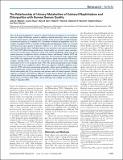The Relationship of Urinary Metabolites of Carbaryl/Naphthalene and Chlorpyrifos with Human Semen Quality

View/
Author
Meeker, John D.
Barr, Dana B.
Bennett, Deborah H.
Bravo, Roberto
Published Version
https://doi.org/10.1289/ehp.7234Metadata
Show full item recordCitation
Meeker, John D., Louise Ryan, Dana B. Barr, Robert F. Herrick, Deborah H. Bennett, Roberto Bravo, and Russ Hauser. 2004. The relationship of urinary metabolites of Carbaryl/Naphthalene and Chlorpyrifos with human semen quality. Environmental Health Perspectives 112(17): 1665-1670.Abstract
Most of the general population is exposed to carbaryl and other contemporary-use insecticides at low levels. Studies of laboratory animals, in addition to limited human data, show an association between carbaryl exposure and decreased semen quality. In the present study we explored whether environmental exposures to 1-naphthol (1N), a metabolite of carbaryl and naphthalene, and 3,5,6-trichloro-2-pyridinol (TCPY), a metabolite of chlorpyrifos and chlorpyrifos-methyl, are associated with decreased semen quality in humans. Subjects (n = 272) were recruited through a Massachusetts infertility clinic. Individual exposures were measured as spot urinary concentrations of 1N and TCPY adjusted using specific gravity. Semen quality was assessed as sperm concentration, percent motile sperm, and percent sperm with normal morphology, along with sperm motion parameters (straight-line velocity, curvilinear velocity, and linearity). Median TCPY and 1N concentrations were 3.22 and 3.19 μg/L, respectively. For increasing 1N tertiles, adjusted odds ratios (ORs) were significantly elevated for below-reference sperm concentration (OR for low, medium, and high tertiles = 1.0, 4.2, 4.2, respectively; p-value for trend = 0.01) and percent motile sperm (1.0, 2.5, 2.4; p-value for trend = 0.01). The sperm motion parameter most strongly associated with 1N was straight-line velocity. There were suggestive, borderline-significant associations for TCPY with sperm concentration and motility, whereas sperm morphology was weakly and nonsignificantly associated with both TCPY and 1N. The observed associations between altered semen quality and 1N are consistent with previous studies of carbaryl exposure, although suggestive associations with TCPY are difficult to interpret because human and animal data are currently limited.Other Sources
http://www.ncbi.nlm.nih.gov/pmc/articles/PMC1253656/pdf/Terms of Use
This article is made available under the terms and conditions applicable to Other Posted Material, as set forth at http://nrs.harvard.edu/urn-3:HUL.InstRepos:dash.current.terms-of-use#LAACitable link to this page
http://nrs.harvard.edu/urn-3:HUL.InstRepos:4596639
Collections
- SPH Scholarly Articles [6362]
Contact administrator regarding this item (to report mistakes or request changes)


